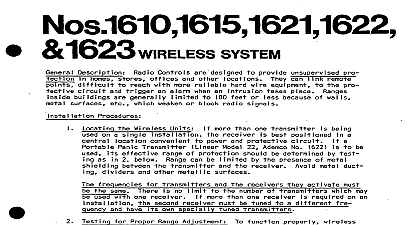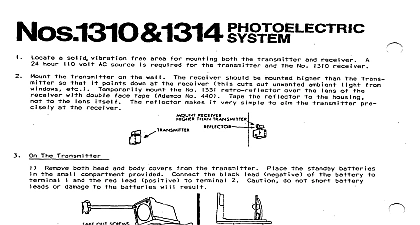Ademco - 1689 & 1684 Receivers (TELSTAT Wireless System)

File Preview
Click below to download for free
Click below to download for free
File Data
| Name | ademco-1689-1684-receivers-telstat-wireless-system-1405286973.pdf |
|---|---|
| Type | |
| Size | 1.99 MB |
| Downloads |
Text Preview
used with TELSTAT Wireless System Transmitters 1661DC 1662 1663 1665 1667 1666 Selection Nos 1680,1684 Wiring and Connections All Transmitters 1681 DC Window Transmitter 1682 Portable Panic Transmitter 1683 Money Clip Transmitter 1687 Gas Detector Transmitter 1689 Smoke Detector Transmitter 1 TELSTAT WIRELESS SYSTEM 2 TRANSMllTER CODING SWITCH AND BATTERY LOCATIONS 3 DIGITAL CODING SWITCH 4 No 1680 RECEIVER PROGRAMMING 8 CONNECTIONS 5 No 1684 RECEIVER PROGRAMMING 81 CONNECTIONS 6 Nos 1681 DC 1685 TRANSMllTER CONNECTIONS 7 LOCATING No 1665 DOOR TRANSMITTER 6 MAGNET for No 1686 DOOR TRANSMllTER 9 MOUNTING TEMPLATE for Nos 1681 DC 1685 TRANSMITTERS Ademco TELSTAT Wireless System may consist of any number of TELSTAT Transmitters used conjunction with a No 1880 Single Channel Receiver or No 1884 Three Channel Receiver Diagram 1 SYSTEM TRANSMITTERS No Channel FIRE Window Transmitter with Closed Circuit Loop Panic Transmitter Clip Transmitter Transmitter with Magnet 8 Built in Contacts Detector Transmitter Detector Transmitter Battery Signal also transmitted when battery weak receiver and all transmitters must be field programmed later No 1664 TELSTAT Receiver has three independent channels that respond individually relay dry contact outputs tripping an alarm control such as a No 1023 or No 342R 50 alarm and panic including money clip and gas transmitters each of these channels can be used for a variety of purposes a No 800LR or 801 LR Assist Alert System digital communicator or tape dialer the same digital code as de like coded fire Channel can be used as a second Burglary Channel if desired to eliminate and the transmitter or can be field programmed the strength of their self contained battery falls to a No 1680 TELSTAT Receiver is a single channel receiver that can receive signals from any like fire panic gas and burglary Status Monitoring response to signals from fire and or panic including money clip gas transmitters open circuit or dry output s of the receiver SPOT alarm relay s can be programmed circuit use and normally presence or absence of an alarm signal The three of the No 1884 and the sole channel of the No 1880 can all be programmed by cut a jumper to latch on the receipt of a transmission A latched burglary channel can thereby possible unwanted recurrent sounding of outside bells etc that have timed out battery signals are transmitted automatically and continually 1881DC 1883 and 1885 Transmitters an optional but No 708 Mini Howler or No 6281 Buzzer and No 884 Switch LED are connected the these low battery signals will be locally annunciated audibly and visually as described Note The No 1889 sounds a self contained audible low battery alert itself and so does not such a message to the receiver Low battery in the No 1882 is indicated its LED does might still be light when its pushbutton The No 1887 does not contain a battery but is powered from the AC outlet which power cord is plugged tmnsmltter while It remains actuated will signal the receiver repeatedly at intervals of it once a minute Note Repeated transmissions Nos 1881 DC and 1885 installed on doors are left open for long periods of time may be optionally eliminated by cutting a windows on those units as described This will extend battery life The Nos 1887 and 1889 continuously while tripped outputs are prioritized The alarm outputs priority detected lower priority alarms will not be detected priority over low battery signals Fire has burglary then panic then low battery For instance when a fire alarm has depressed although successful not in an alarm condition least once a minute neither completely by the user and service company send repeated transmissions while they are some when that condition occurs nor advisable to insure reliable though the system utilizes transmitters as well as repeated low battery indications system like all wireless signal systems periodic a battery No 1687 Gas Detector Tmnsmltter as well as tmnsmltters which opemtlon do those descrtbed herein should be tested by the user at least weekly should be replaced at least every twelve 12 months preferably scheduled and by the service company or within 48 hours of a low battery condition being indicated specified alkaline or carbon zinc batteries such as Eveready Nos 522 216 1222 or MN1604 entire system tested once a year by the service company and the controlled equipment must transmitter s beginning discharge any static electricity you may be carrying This will minimize damage to static electricity sensitive service the receiver physically components terminal 12 ground chance of the battery powered transmitters must be set insure that the receiver will respond only to signals from those transmitters receiver and transmitter contains a Digital Coding Switch with 8 installation are a part of that particular system Switch Location 2 shows the location of the Digital Coding Switches the No 1687 Gas Detector Transmitters see Diagram 1 For the receivers see Diagrams 4 5 The appearance of the coding switch is shown in Diagram 3 Selection that the coding switch contains eight numbered keys each of which may be


